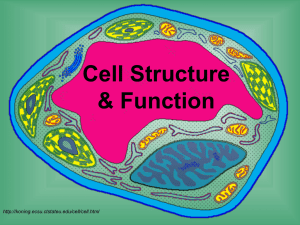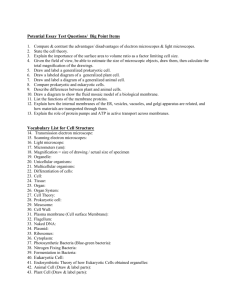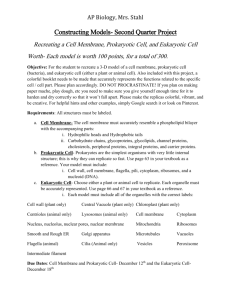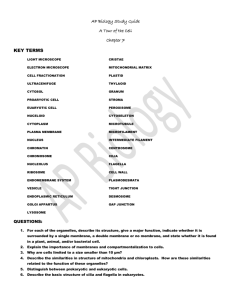Prokaryotic and Eukaryotic Cells
advertisement
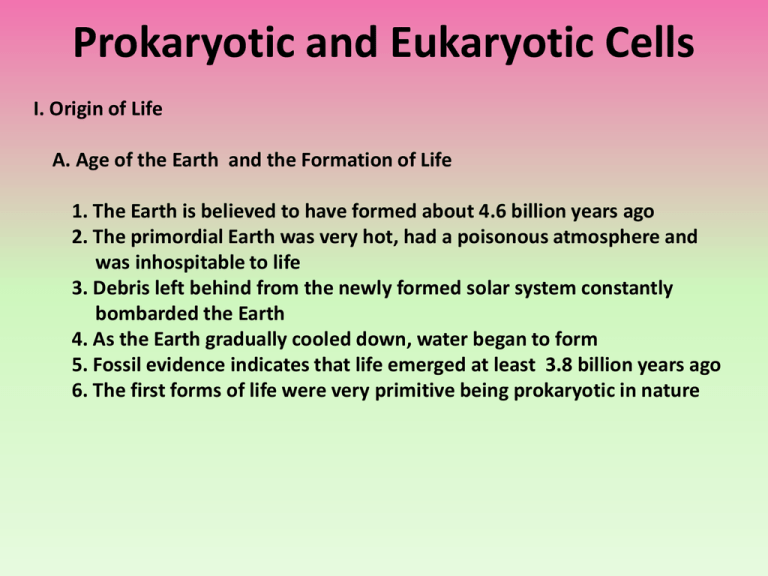
Prokaryotic and Eukaryotic Cells I. Origin of Life A. Age of the Earth and the Formation of Life 1. The Earth is believed to have formed about 4.6 billion years ago 2. The primordial Earth was very hot, had a poisonous atmosphere and was inhospitable to life 3. Debris left behind from the newly formed solar system constantly bombarded the Earth 4. As the Earth gradually cooled down, water began to form 5. Fossil evidence indicates that life emerged at least 3.8 billion years ago 6. The first forms of life were very primitive being prokaryotic in nature 7. The primordial Earth was inhospitable for life to have evolved 10. Fossils of early life approximately 3.5 billion years old II. The Prokaryotic Cell A. Characteristics of the Prokaryotic Cell 1. No membrane-bound organelles 2. DNA is one circular chromosome and is not enclosed within a nuclear membrane 3. DNA is not associated with histone proteins (almost completely naked) 4. Usually have cell walls, and their cell walls usually contain peptidoglycan 5. Reproduce by binary fission 6. Simple flagella having a rotating movement; no cilia 7. Glycocalyx present either as a capsule or slime layer 8. Plasma membrane lacks carbohydrates and sterols, as a rule, but otherwise is similar to eukaryotic membrane that is a bilayer of lipids and floating proteins ("fluid mosaic structure") 9. No cytoskeleton and no cytoplasmic streaming; no centriole 10. Ribosomes are small, 70S type 11. No meiosis occurs; there may be transfer of DNA fragments B. Shapes of Bacteria C. Arrangement of Bacterial Cells 1. Cocci types -diplococci -streptococci -tetrad -sarcinae -staphylococci 2. Bacilli -diplobacilli -streptobacilli -coccobacilli 3. Spiral -vibrio -spirillum -spirochete III. Structures External to the Cell Wall A. Glycocalyx 1. The outermost part of the cell that is composed of glycoproteins 2. If well-developed- capsule 3. If loosely attached - slime layer 4. The glycocalyx is found most commonly in gram-negative bacteria Escherichia coli, Klebsiella pneumoniae, Haemophilus influenzae Pseudomonas aeruginosa, Salmonella species 5. Some Gram-positive bacteria may also have a capsule Bacillus megaterium, Streptococcus pyogenes , Streptococcus pneumoniae B. Flagella 1. A flagellum is a long thread-like appendage that protrudes from the cell body of certain prokaryotic cells and is used in locomotion 2. Bacterial flagella are helical filaments, each with a rotary motor at its base which can turn clockwise or counterclockwise providing two of several kinds of bacterial motility 3. The bacterial flagellum is made up of the protein flagellin 4. Flagella arrangment -monotrichous- single flagellum -lophotrichous- two or more flagella at one pole of the cell -amphitrichous- tuft of flagella at each end of cell -peritrichous- flagella distributed over entire cell 3. Run and tumble -run: rotate counterclockwise tumble: rotate clockwise 4. Taxis -in the cell membrane there are receptors that transmit signals to flagella causing rotation -an attractant- moves toward stimulus and a repellant- movement away from stimulus -some taxis types chemotaxis- response to chemical stimulus phototaxis- response to light aerotaxis is the response of an organism to variation in oxygen concentration magnetotaxis is the ability to sense a magnetic field and coordinate movement in response C. Axial filaments -found inside a sheath that covers spirochetes -found only in spirochetes D. Fimbriae 1. Common to gram negative bacteria only 2. Bristlelike and used for adherence 4. Shorter, straighter, thinner than flagella 5. Bacteria examples E. Sex Pili 1. Rigid tubular structure composed of pilin 2. Used for conjugation in gram negative bacteria IV. The Cell Wall A. Composition and Characteristics 1. Complex, semi-rigid structure that gives bacteria its shape 2. Composed chiefly of carbohydrates and peptides called petidoglycan a. glycan portion- carbohydrate backbone of N-acetylglucosamine (NAG) and N-acetylmuramic acid (NAM) makes alternating disaccharides linked in rows of 10 to 65 sugars b. peptido portion - composed of peptide linkers: -tetrapeptide side chains and peptide cross-bridges Peptidoglycan B. Gram-Positive Cell Wall 1. Thick, strong cell wall composed of many layers of peptidoglycan 2. Teichoic acid makes the cell wall negatively charged a. lipoteichoic acid- spans the petidoglycan layers and anchors the peptidoglycan to the plasma membrane b. wall teichoic acid- linked to peptidoglycan layers C. Gram Negative Cell Wall 1. Composed of one or few layers of peptidoglycan 2. Cannot handle mechanical stress as well as the Gram positive cell wall 3. Contains a wall membrane 4. Lipoproteins of cell wall membrane link to peptidoglycan in the periplasm 5. The periplasm is a liquid-filled space with digestive enzymes and transport proteins 6. Wall membrane -gives it a strong negative charge (phospholipids) -helps the bacteria evade phagocytosis and serves as a barrier to some antibiotics, lysozymes, detergents, heavy metals, bile salts, and some dyes -porin proteins permit passage of nutrients and other materials to enter the periplasmic space Gram stain results Gram Positive Bacteria Gram Negative Bacteria E. Atypical Cell Walls 1. Mycoplasma -no cell wall -smallest bacteria reproducing outside host cell 2. Acid fast cell wall -members of the genus Mycobacterium have an abundance of mycolic acid in their cell walls which makes them waxy and resistant to dessication 3. Archaea -pseudomurein makes up their cell walls F. Damage to the Cell Wall 1. Lysozyme -hydrolize the sugar bonds in Gram positive 2. Penicillins -interferes with peptide cross bridges in Gram positive cell wall V. Structures Internal to the Cell Wall A. Plasma Membrane B. Transport Across the Membrane 1. Simple diffusion 2. Osmosis Solutions isotonic-equilibrium hypertonic- crenation isotonic equilibrium hypertonic- plasmolysis hypotonic- cytolysis hypotonic- turgor 3. Facilitated Diffusion Simple and facilitated diffusion 4. Active Transport -transport against a concentration gradient -requires energy -sodium-potassium pump Proton Pump Facilitated diffusion and active transport compared C. Cytosol D. Genetic Material 1. Genome found in the nucleoid region 2. Plasmids are extra pieces of DNA that may be found in bacteria E. Ribosomes 1. Protein synthesis occurs 2. Ribosomes are composed of proteins and ribosomal RNA F. Endospores Bacillus species Closteridium species G. Binary fission H. Inclusions in Bacterial Cytoplasm 1. Lipid inclusions- stores lipid droplets 2. Magnetosomes- contain magnetite crystals that act like the needle of a compass to orient bacteria in geomagnetic fields 3. Metachromatic granules 4. Sulfur granules 5. Carboxysomes 6. Gas vesicles VI. Eukaryotic Cell A. Eukaryotic Cell Characteristics 1. Features of the eukaryotic cells -1.5 billion years old -have nuclei and organelles -displays a high degree of compartmentalization B. Nucleus 1. Nuclear membrane 2. Nuclear pores 3. Nucleolus 4. Chromatin 5. Nucleosome 5. Nucleosome C. Plasma Membrane http://www.youtube.com/watch?v=GW0lqf4Fqpg&feature=related 1. Fluid Mosaic Model of the Membrane S. J. Singer-Garth Nicholson Model -human-mouse cell fusion -freeze-fracture freeze-etch technique YouTubeYouTube - Fluid Mosaic Model 2. Phospholipids -hydrophilic heads -hydrophobic tails -move laterally through membrane 3. Proteins -hydrophilic/hydrophobic regions -integral -peripheral -protein functions D. Endomembrane System 2. Endoplasmic reticulum (ER) a. rough ER b. smooth ER ER, ribosomes, and the Golgi structure working together Secretion of proteins Lysosomes are made by the Golgi body -contains hydrolytic enzymes -can merge with a vacuole and undergo phagocytosis -can merge with an organelle and undergo autophagy Autophagy of a “worn out” mitochondrion by a lysosome E. Mitochondria 1. Site of true respiration 2. Structural features -outer membrane -inner membrane -cristae -matrix F. Chloroplasts 1. Site of photosynthesis 2. Contains chlorophyll, xanthophylls, and carotenoids 3. Structural features outer membrane inner membrane granum thylakoid stroma G. Cell Wall 1. Primary 2. Secondary 3. Middle lamella H. Cytoplasm A. Cytoplasmic Streaming (Cyclosis) Amoeba Elodea I. Cytoskeleton Components 1. Microtubules 2. Intermediate filaments 3. Microfilaments 1. Microtubules Flagellum or cilium structure Microtubules compose spindle fibers 2. Intermediate filaments 3. Microfilaments Microfilaments reinforce the microvilli of the intestine VI. Endosymbiotic Hypothesis A. Lynn Margulis 1. Best known for her theory on the origin of eukaryotic organelles, and her contributions to the endosymbiotic theory B. Origin of the Mitochondria C. Origin of the Chloroplasts

